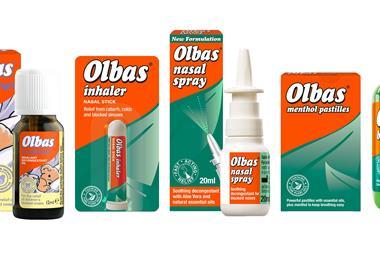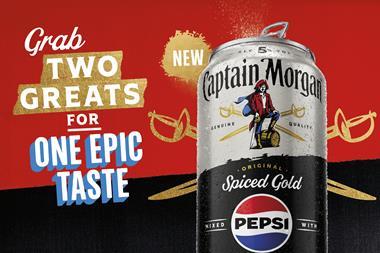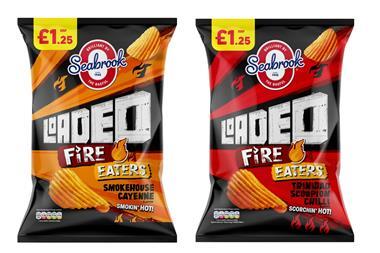with a household penetration of 98%, milk is big business for convenience stores. But its high consumption rate can mean that people don't really give its purchase much thought. Nevertheless, manufacturers are fighting hard to bring the white stuff out of the dark.
One brand that has been making a real effort to stand out from the crowd is Arla's Cravendale. The brand's quirky cow, pirate and cyclist ads certainly have a point of difference from the usual 'cow in a field' offering. "It's all about behaving in a way you wouldn't expect a milk brand to," says Cravendale group brand manager Louise Barton. "People don't spend time thinking about milk, so we needed to get them to re-evaluate their relationship with it. We need people to have an opinion on milk."
The £127m brand, which has grown 31% year on year, is launching new pack designs in mid March and will be on air intermittently throughout 2008.
"Convenience has been an area of huge growth for us," says Barton. "Our milk is easier to handle as it lasts longer and there's less wastage for retailers."
As well the benefits of providing both retailers and consumers with a longer-life milk, Arla is keen to raise awareness of the filtered milk's health benefits. "We're the first milk brand to be endorsed by the British Dental Foundation," says Barton. "And we're also looking to commission research to show how Cravendale can help you sleep better due to its melatonin levels."
Another milk that's gaining valuable sales thanks to its health credentials is Robert Wiseman Dairies' 1% fat milk The One. Sales and marketing director Sandie Wilkie claims that keeping the brand's message simple has been core to its success. "We used to advertise it as 'The One that I want', but our consumer research showed that people didn't really understand what we were offering them," he says. "In 2009 our ads will have a simpler message showing that we've kept the flavour, but reduced the fat."
The milk's healthy image has entitled it to a nod from the Food Standards Agency (FSA). "As part of the FSA's saturated fat reduction campaign, it is advising consumers to downgrade the fat content of their milk and plans to put an endorsement on The One in 2ltr, 750ml and 250ml formats," says Wilkie.
Dairy Crest also acknowledges that highlighting a product's health benefits is key to success. "In liquid milk the health trend is a clear driver, through the growing introduction of 1% milk or clearer fat labelling within ranges to aid consumer awareness and education," says head of marketing - liquids Steve Horton.
"Increasing awareness of the effects of saturated fats in particular raises interesting challenges and opportunities for the milk and cream sector. There is a balance to be struck as consumers are increasingly reluctant to compromise on taste and naturalness for the sake of health.
"The success of 1% fat milk lies in the fact that the taste profile is not noticeably different to that of the well-established semi-skimmed milk."
But while consumers are looking to buy lower fat milk, cream appears to have slipped through the net. "When it comes to cream, health is less of an issue," says Horton. "It is a more luxury product that's not consumed in such great volumes. The key drivers here are taste, naturalness and provenance."
French manufacturer Isigny Sainte-Mère couldn't agree more. "There is a super opportunity for convenience retailers to improve their offering by providing shoppers with a range that includes products with real provenance," says European export manager Stéphane Plessis.
"Our range includes Isigny AOC Crème Fraîche - the only crème fraîche product that has protected origin status." The company is planning to build up its reputation in the UK by introducing consumers to provenance-inspired competitions. "We'll be looking at promotions such as design a recipe with our product and win a trip to Normandy (where the cheese is sourced)," says Plessis.
Local links
In addition to provenance, Dairy Crest believes that locally produced milks and creams also sell well. "In times of recession people stay closer to home to source their products as they look to support their 'own' economy," says Horton. "Country Life has invested heavily in communicating its British origins in order to capitalise on this trend. The convenience sector is no less affected by this trend than the major multiples, and should be endeavouring to buy British and where possible, buy local."
Wiseman's Wilkie explains that this is particularly important in regions where patriotism is prevalent. "Cornwall and Devon are very patriotic," he claims. "You can't buy Cornish clotted cream in Devon - they want Devonshire!"
Wiseman has launched locally branded milk in Cornwall, Devon, Somerset and Grampian. "We're also planning to introduce Scottish Dairy milk in central Scotland," he reveals.
While local produce appears to be a hit with shoppers, other specialist milks could also prove popular, according to Robert Graham, managing director of Graham's Family Dairy. "Niche lines, particularly organic products, are being overlooked by retailers," he points out. "There may have been no growth in it, but our volumes are still pretty rock solid."
He claims that many people falsely perceive organic milk to be expensive. "The price difference from a standard pint of milk and an organic one is about 5p, which isn't much compared with other food categories such as salmon."
Graham advises c-stores to be more open-minded about stocking organic. "We encourage c-store retailers to take a range of products and there can be resistance to organic, but those who do stock it generally find it sells."
However, Wilkie warns that in the current economic climate, organic may be too big a risk for c-stores: "People aren't buying at the same rate they were six months ago, particularly with niche products, such as organic."
Keeping up appearances
Instead of adding niche lines to their ranges, Wilkie suggests retailers look at multi-siting their existing lines. "Not all c-store retailers are considering secondary or tertiary sitings of milk - they just put a single display at the back of stores, thinking that if people want it, they'll find it," he says. "But that's old thinking. We've tested putting a second chiller by the door and we've watched people on CCTV seeing it while they are shopping for other products, and then remembering that they need to buy some milk."
Signposting is another way for retailers to point shoppers in the right direction. Wiseman provides its key c-store customers with illuminated milk headers above the chillers, and wings which display pictures of the product.
The outside of a store can also be used to encourage milk sales. "Shop windows used to be cluttered with posters, but a big trend is to put up a bright, wholesome food image instead," says Wilkie. "We can help stores to achieve a modern appearance with our window decals that display milk photos."
Wilkie also says that the milk display itself can affect consumer buying habits. "Traditionally, retailers would have a milk fridge with the larger containers stuck right at the bottom. We are trying to convert store owners to the theory that 'eye level is buy level'. We're telling retailers to move 2ltr semi-skimmed - the fastest-selling line - up to eye level. It makes a huge difference to sales, so it's important to replenish shelves regularly."
Another pack size that Wiseman hopes will become a big seller is its new 750ml format. "We're introducing a new size of pack never used before because we think that the pint carton is in the past," says Wilkie.
"Modern technology has allowed manufacturers to lengthen the life of milk. It now lasts up to about nine days, so consumers can now afford to buy larger packs. We're gradually replacing semi-skimmed pint cartons with new 750ml size packs, which take up less space in the fridge."
One brand that has been making a real effort to stand out from the crowd is Arla's Cravendale. The brand's quirky cow, pirate and cyclist ads certainly have a point of difference from the usual 'cow in a field' offering. "It's all about behaving in a way you wouldn't expect a milk brand to," says Cravendale group brand manager Louise Barton. "People don't spend time thinking about milk, so we needed to get them to re-evaluate their relationship with it. We need people to have an opinion on milk."
The £127m brand, which has grown 31% year on year, is launching new pack designs in mid March and will be on air intermittently throughout 2008.
"Convenience has been an area of huge growth for us," says Barton. "Our milk is easier to handle as it lasts longer and there's less wastage for retailers."
As well the benefits of providing both retailers and consumers with a longer-life milk, Arla is keen to raise awareness of the filtered milk's health benefits. "We're the first milk brand to be endorsed by the British Dental Foundation," says Barton. "And we're also looking to commission research to show how Cravendale can help you sleep better due to its melatonin levels."
Another milk that's gaining valuable sales thanks to its health credentials is Robert Wiseman Dairies' 1% fat milk The One. Sales and marketing director Sandie Wilkie claims that keeping the brand's message simple has been core to its success. "We used to advertise it as 'The One that I want', but our consumer research showed that people didn't really understand what we were offering them," he says. "In 2009 our ads will have a simpler message showing that we've kept the flavour, but reduced the fat."
The milk's healthy image has entitled it to a nod from the Food Standards Agency (FSA). "As part of the FSA's saturated fat reduction campaign, it is advising consumers to downgrade the fat content of their milk and plans to put an endorsement on The One in 2ltr, 750ml and 250ml formats," says Wilkie.
Dairy Crest also acknowledges that highlighting a product's health benefits is key to success. "In liquid milk the health trend is a clear driver, through the growing introduction of 1% milk or clearer fat labelling within ranges to aid consumer awareness and education," says head of marketing - liquids Steve Horton.
"Increasing awareness of the effects of saturated fats in particular raises interesting challenges and opportunities for the milk and cream sector. There is a balance to be struck as consumers are increasingly reluctant to compromise on taste and naturalness for the sake of health.
"The success of 1% fat milk lies in the fact that the taste profile is not noticeably different to that of the well-established semi-skimmed milk."
But while consumers are looking to buy lower fat milk, cream appears to have slipped through the net. "When it comes to cream, health is less of an issue," says Horton. "It is a more luxury product that's not consumed in such great volumes. The key drivers here are taste, naturalness and provenance."
French manufacturer Isigny Sainte-Mère couldn't agree more. "There is a super opportunity for convenience retailers to improve their offering by providing shoppers with a range that includes products with real provenance," says European export manager Stéphane Plessis.
"Our range includes Isigny AOC Crème Fraîche - the only crème fraîche product that has protected origin status." The company is planning to build up its reputation in the UK by introducing consumers to provenance-inspired competitions. "We'll be looking at promotions such as design a recipe with our product and win a trip to Normandy (where the cheese is sourced)," says Plessis.
Local links
In addition to provenance, Dairy Crest believes that locally produced milks and creams also sell well. "In times of recession people stay closer to home to source their products as they look to support their 'own' economy," says Horton. "Country Life has invested heavily in communicating its British origins in order to capitalise on this trend. The convenience sector is no less affected by this trend than the major multiples, and should be endeavouring to buy British and where possible, buy local."
Wiseman's Wilkie explains that this is particularly important in regions where patriotism is prevalent. "Cornwall and Devon are very patriotic," he claims. "You can't buy Cornish clotted cream in Devon - they want Devonshire!"
Wiseman has launched locally branded milk in Cornwall, Devon, Somerset and Grampian. "We're also planning to introduce Scottish Dairy milk in central Scotland," he reveals.
While local produce appears to be a hit with shoppers, other specialist milks could also prove popular, according to Robert Graham, managing director of Graham's Family Dairy. "Niche lines, particularly organic products, are being overlooked by retailers," he points out. "There may have been no growth in it, but our volumes are still pretty rock solid."
He claims that many people falsely perceive organic milk to be expensive. "The price difference from a standard pint of milk and an organic one is about 5p, which isn't much compared with other food categories such as salmon."
Graham advises c-stores to be more open-minded about stocking organic. "We encourage c-store retailers to take a range of products and there can be resistance to organic, but those who do stock it generally find it sells."
However, Wilkie warns that in the current economic climate, organic may be too big a risk for c-stores: "People aren't buying at the same rate they were six months ago, particularly with niche products, such as organic."
Keeping up appearances
Instead of adding niche lines to their ranges, Wilkie suggests retailers look at multi-siting their existing lines. "Not all c-store retailers are considering secondary or tertiary sitings of milk - they just put a single display at the back of stores, thinking that if people want it, they'll find it," he says. "But that's old thinking. We've tested putting a second chiller by the door and we've watched people on CCTV seeing it while they are shopping for other products, and then remembering that they need to buy some milk."
Signposting is another way for retailers to point shoppers in the right direction. Wiseman provides its key c-store customers with illuminated milk headers above the chillers, and wings which display pictures of the product.
The outside of a store can also be used to encourage milk sales. "Shop windows used to be cluttered with posters, but a big trend is to put up a bright, wholesome food image instead," says Wilkie. "We can help stores to achieve a modern appearance with our window decals that display milk photos."
Wilkie also says that the milk display itself can affect consumer buying habits. "Traditionally, retailers would have a milk fridge with the larger containers stuck right at the bottom. We are trying to convert store owners to the theory that 'eye level is buy level'. We're telling retailers to move 2ltr semi-skimmed - the fastest-selling line - up to eye level. It makes a huge difference to sales, so it's important to replenish shelves regularly."
Another pack size that Wiseman hopes will become a big seller is its new 750ml format. "We're introducing a new size of pack never used before because we think that the pint carton is in the past," says Wilkie.
"Modern technology has allowed manufacturers to lengthen the life of milk. It now lasts up to about nine days, so consumers can now afford to buy larger packs. We're gradually replacing semi-skimmed pint cartons with new 750ml size packs, which take up less space in the fridge."
marketing
Convenience retailers could see their milk sales rocket if plans for a nationwide milk marketing campaign go ahead.
The campaign, which has been put forward by the UK Milk Marketing Forum, follows Scotland's successful Milk Moustache campaign. "The campaign worked so well in Scotland that we set up the UK Milk Marketing Forum," says Robert Wiseman Dairies sales and marketing director Sandie Wilkie. "We've appointed a co-ordinator and put money in the kitty for a three-year campaign starting in autumn. I've sent the application to Brussels for match funding and we should hear back in June."
The Scottish campaign is supported by five of Scotland's leading dairies: Grahams Family Dairy, Scottish Milk Dairies, Robert Wiseman Dairies, Mitchells Dairies and Arla Foods. Celebrities including tennis star Andy Murray and Extras actress Ashley Jensen (right), have taken part.
According to Robert Wiseman Dairies, independent research on the campaign showed it improved young people's perceptions about milk.
Convenience retailers could see their milk sales rocket if plans for a nationwide milk marketing campaign go ahead.
The campaign, which has been put forward by the UK Milk Marketing Forum, follows Scotland's successful Milk Moustache campaign. "The campaign worked so well in Scotland that we set up the UK Milk Marketing Forum," says Robert Wiseman Dairies sales and marketing director Sandie Wilkie. "We've appointed a co-ordinator and put money in the kitty for a three-year campaign starting in autumn. I've sent the application to Brussels for match funding and we should hear back in June."
The Scottish campaign is supported by five of Scotland's leading dairies: Grahams Family Dairy, Scottish Milk Dairies, Robert Wiseman Dairies, Mitchells Dairies and Arla Foods. Celebrities including tennis star Andy Murray and Extras actress Ashley Jensen (right), have taken part.
According to Robert Wiseman Dairies, independent research on the campaign showed it improved young people's perceptions about milk.
retailer opinion
"We currently stock Nisa-Today's Heritage milk. The shelf-life is fantastic - about six or seven days once it's in-store. With our past suppliers, we found that the milk wasn't always sealed properly and was going sour, which is obviously completely unacceptable.
"We have a 1.8 metre chiller cabinet and we stock whole and semi-skimmed pints, whole, semi-skimmed, skimmed and organic 2pts, and whole and semi-skimmed 4pts.
"We sell 35 organic milks a week, which is better than I'd expected. We sell 231 semi-skimmed 1pts a week and 182 of the 2pts.
"If there was demand for 1% milk then we'd look into it, but so far there hasn't been any."
Andrew Collier, store manager, Costcutter, Newport
"We currently stock Nisa-Today's Heritage milk. The shelf-life is fantastic - about six or seven days once it's in-store. With our past suppliers, we found that the milk wasn't always sealed properly and was going sour, which is obviously completely unacceptable.
"We have a 1.8 metre chiller cabinet and we stock whole and semi-skimmed pints, whole, semi-skimmed, skimmed and organic 2pts, and whole and semi-skimmed 4pts.
"We sell 35 organic milks a week, which is better than I'd expected. We sell 231 semi-skimmed 1pts a week and 182 of the 2pts.
"If there was demand for 1% milk then we'd look into it, but so far there hasn't been any."
Andrew Collier, store manager, Costcutter, Newport
























No comments yet